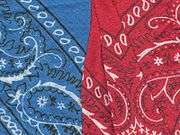Kerchief
A kerchief (from the French couvre-chef, "head cover"), also known as a bandana or/and bandanna, is a triangular or square piece of cloth tied around the head, face or neck for protective or decorative purposes. During the COVID-19 pandemic, many people have used bandanas for protection instead of face masks. The popularity of head kerchiefs may vary by culture or religion, and may vary among Orthodox Jewish and Christian, Catholic, Amish, and Muslim people.

The neckerchief and handkerchief are related items.
Types
Bandana

A bandana or bandanna (from Sanskrit बन्धन or bandhana, "a bond")[1][2] is a type of large, usually colourful kerchief, originating from the Indian subcontinent, often worn on the head or around the neck of a person. It is considered to be a hat by some. Bandanas are frequently printed in a paisley pattern and are most often used to hold hair back, either as a fashionable head accessory, or for practical purposes. It is also used to tie around the neck to prevent sunburn, and around the mouth and nose to protect from dust inhalation or to hide the identity of its wearer. Bandanas originated in India as bright coloured handkerchiefs of silk and cotton with spots in white on coloured grounds, chiefly red and blue Bandhani. The silk styles were made of the finest quality yarns, and were very popular. Bandana prints for clothing were first produced in Glasgow from cotton yarns, and are now made in many qualities. The term, at present, generally means a fabric in printed styles, whether silk, silk and cotton, or all cotton.[3]
The word bandana stems from the Hindi words 'bāndhnū,' or "tie-dyeing," and 'bāndhnā,' "to tie." These stem from Sanskrit roots 'badhnāti,' "he ties," and Sanskrit 'bandhana' (बन्धन), "a bond."[4] In the 18th and 19th centuries bandanas were frequently known as bandannoes.[5]
Oramal
A traditional kerchief used in Central Asia and the Caucasus (note how it is banded, the neck is usually not covered by it). In some countries like Uzbekistan it was traditionally used only at home, while in public the paranja was more popular (now used at public as paranja now is illegal). In other countries, like Kazakhstan, it was commonly used in public. In Kyrgyzstan, the white color is an indication that the woman is married.
As well it was widely used by men at horse riding at summertime instead of cap.
Pañuelo
Pañuelo (from Spanish paño + -uelo) or alampay in the Philippines were lace-like embroidered neck scarves worn around the shoulders over the camisa (blouse). They were traditionally made from piña or abaca fiber. They were an intrinsic part of the traditional traje de mestiza women's attire, along with the tapis and the abaniko fans. They were worn in the 18th and 19th centuries but are rarely used today in modern versions of the terno dress.[6]
 La Bulaqueña, an 1895 painting of a woman wearing a traje de mestiza with a pañuelo
La Bulaqueña, an 1895 painting of a woman wearing a traje de mestiza with a pañuelo_MET_115249a.jpg) Early 19th century pañuelo in the Metropolitan Museum of Art
Early 19th century pañuelo in the Metropolitan Museum of Art
Headscarves
Kerchiefs are also worn as headdresses by Austronesian cultures in maritime Southeast Asia. Among Malay men it is known as tengkolok, it is worn traditional occasions, such as weddings (worn by the groom) and the pesilat.
See also
|
Other neckwear:
|
Other headwear
|
References
Citations
- "Definition of bandanna". Merriam-webster.com. 2012-08-31. Retrieved 2013-03-15.
- "Bandanna from Dictionary.com". Dictionary.reference.com. Retrieved 2013-03-15.
- Curtis, H. P. (1921). Glossary of Textile Terms. Marsden & Co. Ltd.
- "Bandanna from Dictionary.com". Dictionary.reference.com. Retrieved 2017-06-10.
- Yule and Burnell (2013), "Bandanna", p.78.
- "Terno". SEASite. Center for Southeast Asian Studies, Northern Illinois University. Retrieved 16 December 2018.
Sources
- Yule, Henry, & A.C. Burnell (2013). Hobson-Jobson: The Definitive Glossary of British India. (Oxford, England: OUP). ISBN 9780191645839.
External links
| Wikisource has the text of the 1911 Encyclopædia Britannica article Bandana. |
| Wikimedia Commons has media related to Kerchiefs. |



.jpg)